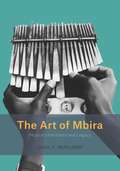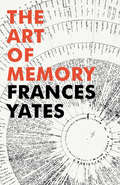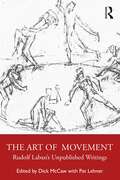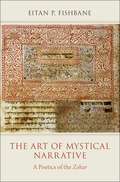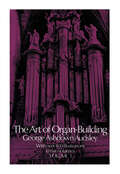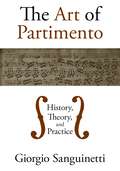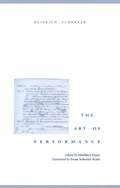- Table View
- List View
The Art of Living Well: Moral Experience and Virtue Ethics
by Paul van TongerenThe first English translation of the prize winning Dutch title Leven is Een Kunst, this is a fascinating book, in which prominent ethicist and Nietzsche specialist Paul van Tongeren creates a contemporary version of classical virtue ethics. Virtue ethics goes right back to the moral philosophy of Aristotle and some could argue is nothing new. However, Van Tongeren demonstrates how the original Artistotlean approach been extended and corrected throughout the centuries by the Stoics, Christianity, and Nietzsche and how we now need new kind of ethics - a creative, artful ethics that takes seriously the desire to 'live well'. Acting as both a brilliantly clear introduction to virtue ethics and moral philosophy and a serious work of original philosophy, this book connects philosophy with real lived experience and tackles, head-on, the perennial philosophical question: how do we live well?
The Art of Living Well: Moral Experience and Virtue Ethics
by Paul van TongerenThe first English translation of the prize winning Dutch title Leven is Een Kunst, this is a fascinating book, in which prominent ethicist and Nietzsche specialist Paul van Tongeren creates a contemporary version of classical virtue ethics. Virtue ethics goes right back to the moral philosophy of Aristotle and some could argue is nothing new. However, Van Tongeren demonstrates how the original Artistotlean approach been extended and corrected throughout the centuries by the Stoics, Christianity, and Nietzsche and how we now need new kind of ethics - a creative, artful ethics that takes seriously the desire to 'live well'. Acting as both a brilliantly clear introduction to virtue ethics and moral philosophy and a serious work of original philosophy, this book connects philosophy with real lived experience and tackles, head-on, the perennial philosophical question: how do we live well?
The Art of Looking: How to Read Modern and Contemporary Art
by Lance EsplundA veteran art critic helps us make sense of modern and contemporary artThe landscape of contemporary art has changed dramatically during the last hundred years: from Malevich's 1915 painting of a single black square and Duchamp's 1917 signed porcelain urinal to Jackson Pollock's midcentury "drip" paintings; Chris Burden's "Shoot" (1971), in which the artist was voluntarily shot in the arm with a rifle; Urs Fischer's "You" (2007), a giant hole dug in the floor of a New York gallery; and the conceptual and performance art of today's Ai Weiwei and Marina Abramovic. The shifts have left the art-viewing public (understandably) perplexed.In The Art of Looking, renowned art critic Lance Esplund demonstrates that works of modern and contemporary art are not as indecipherable as they might seem. With patience, insight, and wit, Esplund guides us through the last century of art and empowers us to approach and appreciate it with new eyes. Eager to democratize genres that can feel inaccessible, Esplund encourages viewers to trust their own taste, guts, and common sense. The Art of Looking will open the eyes of viewers who think that recent art is obtuse, nonsensical, and irrelevant, as well as the eyes of those who believe that the art of the past has nothing to say to our present.
The Art of Looking: How to Read Modern and Contemporary Art
by Lance EsplundA veteran art critic helps us make sense of modern and contemporary art The landscape of contemporary art has changed dramatically during the last hundred years: from Malevich's 1915 painting of a single black square and Duchamp's 1917 signed porcelain urinal to Jackson Pollock's midcentury "drip" paintings; Chris Burden's "Shoot" (1971), in which the artist was voluntarily shot in the arm with a rifle; Urs Fischer's "You" (2007), a giant hole dug in the floor of a New York gallery; and the conceptual and performance art of today's Ai Weiwei and Marina Abramovic. The shifts have left the art-viewing public (understandably) perplexed. In The Art of Looking, renowned art critic Lance Esplund demonstrates that works of modern and contemporary art are not as indecipherable as they might seem. With patience, insight, and wit, Esplund guides us through the last century of art and empowers us to approach and appreciate it with new eyes. Eager to democratize genres that can feel inaccessible, Esplund encourages viewers to trust their own taste, guts, and common sense. The Art of Looking will open the eyes of viewers who think that recent art is obtuse, nonsensical, and irrelevant, as well as the eyes of those who believe that the art of the past has nothing to say to our present.
The Art of Mary Linwood: Embroidery, Installation, and Entrepreneurship in Britain, 1787-1845 (Material Culture of Art and Design)
by Dr. Heidi A. StrobelThe Art of Mary Linwood is the first book on Leicester textile artist Mary Linwood (1755-1845) and catalogue of her work. When British textile artist and gallery owner Mary Linwood died in 1845 just shy of 90 years old, her estate was worth the equivalent of £5,199,822 in today's currency. As someone who made, but did not sell, embroidered replicas of famous artworks after artists such as Gainsborough, Reynolds, Stubbs, and Morland, how did she accumulate so much money? A pioneering woman in the male-dominated art world of late Georgian Britain, Linwood established her own London gallery in 1798 that featured copies of well-known paintings by these popular artists. Featuring props and specially designed rooms for her replicas, she ensured that her visitors had an entertaining, educational, and kinetic tour, similar to what Madame Tussaud would do one generation later. The gallery's focus on picturesque painters provided her London visitors with an idyllic imaginary journey through the countryside. Its emphasis on quintessentially British artists provided a unifying focus for a country that had recently emerged from the threat of Napoleonic invasion.This book brings to the fore Linwood's gallery guides and previously unpublished letters to her contemporaries, such as Birmingham inventor Matthew Boulton and Queen Charlotte. It also includes the first and only catalogue of Linwood's extant and destroyed works. By examining Linwood's replicas and their accompanying objects through the lens of material culture, the book provides a much-needed contribution to the scholarship on women and cultural agency in the early 19th century.
The Art of Mary Linwood: Embroidery, Installation, and Entrepreneurship in Britain, 1787-1845 (Material Culture of Art and Design)
by Dr. Heidi A. StrobelThe Art of Mary Linwood is the first book on Leicester textile artist Mary Linwood (1755-1845) and catalogue of her work. When British textile artist and gallery owner Mary Linwood died in 1845 just shy of 90 years old, her estate was worth the equivalent of £5,199,822 in today's currency. As someone who made, but did not sell, embroidered replicas of famous artworks after artists such as Gainsborough, Reynolds, Stubbs, and Morland, how did she accumulate so much money? A pioneering woman in the male-dominated art world of late Georgian Britain, Linwood established her own London gallery in 1798 that featured copies of well-known paintings by these popular artists. Featuring props and specially designed rooms for her replicas, she ensured that her visitors had an entertaining, educational, and kinetic tour, similar to what Madame Tussaud would do one generation later. The gallery's focus on picturesque painters provided her London visitors with an idyllic imaginary journey through the countryside. Its emphasis on quintessentially British artists provided a unifying focus for a country that had recently emerged from the threat of Napoleonic invasion.This book brings to the fore Linwood's gallery guides and previously unpublished letters to her contemporaries, such as Birmingham inventor Matthew Boulton and Queen Charlotte. It also includes the first and only catalogue of Linwood's extant and destroyed works. By examining Linwood's replicas and their accompanying objects through the lens of material culture, the book provides a much-needed contribution to the scholarship on women and cultural agency in the early 19th century.
The Art of Mbira: Musical Inheritance and Legacy (Chicago Studies in Ethnomusicology)
by Paul F. BerlinerGrowing out of the collaborative research of an American ethnomusicologist and Zimbabwean musician, Paul F. Berliner’s The Art of Mbira documents the repertory for a keyboard instrument known generally as mbira. At the heart of this work lies the analysis of the improvisatory processes that propel mbira music’s magnificent creativity. In this book, Berliner provides insight into the communities of study, performance, and worship that surround mbira. He chronicles how master player Cosmas Magaya and his associates have developed their repertory and practices over more than four decades, shaped by musical interaction, social and political dynamics in Zimbabwe, and the global economy of the music industry. At once a detailed exposition of the music’s forms and practices, it is also an indispensable historical and cultural guide to mbira in a changing world. Together with Berliner and Magaya's compendium of mbira compositions, Mbira’s Restless Dance, The Art of Mbira breaks new ground in the depth and specificity of its exploration of an African musical tradition, and in the entwining of the authors’ collaborative voices. It is a testament to the powerful relationship between music and social life—and the rewards of lifelong musical study, performance, and friendship.
The Art of Mbira: Musical Inheritance and Legacy (Chicago Studies in Ethnomusicology)
by Paul F. BerlinerGrowing out of the collaborative research of an American ethnomusicologist and Zimbabwean musician, Paul F. Berliner’s The Art of Mbira documents the repertory for a keyboard instrument known generally as mbira. At the heart of this work lies the analysis of the improvisatory processes that propel mbira music’s magnificent creativity. In this book, Berliner provides insight into the communities of study, performance, and worship that surround mbira. He chronicles how master player Cosmas Magaya and his associates have developed their repertory and practices over more than four decades, shaped by musical interaction, social and political dynamics in Zimbabwe, and the global economy of the music industry. At once a detailed exposition of the music’s forms and practices, it is also an indispensable historical and cultural guide to mbira in a changing world. Together with Berliner and Magaya's compendium of mbira compositions, Mbira’s Restless Dance, The Art of Mbira breaks new ground in the depth and specificity of its exploration of an African musical tradition, and in the entwining of the authors’ collaborative voices. It is a testament to the powerful relationship between music and social life—and the rewards of lifelong musical study, performance, and friendship.
The Art of Mbira: Musical Inheritance and Legacy (Chicago Studies in Ethnomusicology)
by Paul F. BerlinerGrowing out of the collaborative research of an American ethnomusicologist and Zimbabwean musician, Paul F. Berliner’s The Art of Mbira documents the repertory for a keyboard instrument known generally as mbira. At the heart of this work lies the analysis of the improvisatory processes that propel mbira music’s magnificent creativity. In this book, Berliner provides insight into the communities of study, performance, and worship that surround mbira. He chronicles how master player Cosmas Magaya and his associates have developed their repertory and practices over more than four decades, shaped by musical interaction, social and political dynamics in Zimbabwe, and the global economy of the music industry. At once a detailed exposition of the music’s forms and practices, it is also an indispensable historical and cultural guide to mbira in a changing world. Together with Berliner and Magaya's compendium of mbira compositions, Mbira’s Restless Dance, The Art of Mbira breaks new ground in the depth and specificity of its exploration of an African musical tradition, and in the entwining of the authors’ collaborative voices. It is a testament to the powerful relationship between music and social life—and the rewards of lifelong musical study, performance, and friendship.
The Art of Mechanical Reproduction: Technology and Aesthetics from Duchamp to the Digital
by Tamara TroddThe Art of Mechanical Reproduction presents a striking new approach to how traditional art mediums—painting, sculpture, and drawing—changed in the twentieth century in response to photography, film, and other technologies. Countering the modernist view that the medium provides advanced art with “resistance” against technological pressures, Tamara Trodd argues that we should view art and its practices as imaginatively responding to the potential that artists glimpsed in mechanical reproduction, putting art into dialogue with the commercial cultures of its time. The Art of Mechanical Reproduction weaves a rich history of the experimental networks in which artists as diverse as Paul Klee, Hans Bellmer, Ellsworth Kelly, Robert Smithson, Gerhard Richter, Chris Marker, and Tacita Dean have worked, and it shows for the first time how extensively technological innovations of the moment have affected their work. Original and broad-ranging, The Art of Mechanical Reproduction challenges some of the most respected and entrenched criticism of the past several decades—and allows us to think about these artists anew.
The Art of Mechanical Reproduction: Technology and Aesthetics from Duchamp to the Digital
by Tamara TroddThe Art of Mechanical Reproduction presents a striking new approach to how traditional art mediums—painting, sculpture, and drawing—changed in the twentieth century in response to photography, film, and other technologies. Countering the modernist view that the medium provides advanced art with “resistance” against technological pressures, Tamara Trodd argues that we should view art and its practices as imaginatively responding to the potential that artists glimpsed in mechanical reproduction, putting art into dialogue with the commercial cultures of its time. The Art of Mechanical Reproduction weaves a rich history of the experimental networks in which artists as diverse as Paul Klee, Hans Bellmer, Ellsworth Kelly, Robert Smithson, Gerhard Richter, Chris Marker, and Tacita Dean have worked, and it shows for the first time how extensively technological innovations of the moment have affected their work. Original and broad-ranging, The Art of Mechanical Reproduction challenges some of the most respected and entrenched criticism of the past several decades—and allows us to think about these artists anew.
The Art of Memory
by Frances A. YatesOne of Modern Library's 100 Best Nonfiction Books of the Twentieth Century In this classic study of how people learned to retain vast stores of knowledge before the invention of the printed page, Frances A. Yates traces the art of memory from its treatment by Greek orators, through its Gothic transformations in the Middle Ages, to the occult forms it took in the Renaissance, and finally to its use in the seventeenth century. This book, the first to relate the art of memory to the history of culture as a whole, was revolutionary when it first appeared and continues to mesmerize readers with its lucid and revelatory insights.
The Art of Memory
by Frances A YatesThis unique and brilliant book is a history of human knowledge. Before the invention of printing, a trained memory was of vital importance. Based on a technique of impressing 'places' and 'images' on the mind, the ancient Greeks created an elaborate memory system which in turn was inherited by the Romans and passed into the European tradition, to be revived, in occult form, during the Renaissance. Frances Yates sheds light on Dante’s Divine Comedy, the form of the Shakespearian theatre and the history of ancient architecture; The Art of Memory is an invaluable contribution to aesthetics and psychology, and to the history of philosophy, of science and of literature.
The Art of Midwifery: Early Modern Midwives in Europe
by Hilary MarlandThe Art of Midwifery is the first book to examine midwives' lives and work across Europe in the early modern period. Drawing on a vast range of archival material from England, Holland, Germany, France, Italy and Spain, the contributors show the diversity in midwives' practices, competence, socio-economic background and education, as well as their public function and image. The Art of Midwifery is an excellent resource for students of women's history, social history and medical history.
The Art of Midwifery: Early Modern Midwives in Europe (Wellcome Institute Series In The History Of Medicine)
by Hilary MarlandThe Art of Midwifery is the first book to examine midwives' lives and work across Europe in the early modern period. Drawing on a vast range of archival material from England, Holland, Germany, France, Italy and Spain, the contributors show the diversity in midwives' practices, competence, socio-economic background and education, as well as their public function and image. The Art of Midwifery is an excellent resource for students of women's history, social history and medical history.
The Art of Military Innovation: Lessons From The Israel Defense Forces
by Edward N. Luttwak Eitan ShamirA world-leading military strategist and an IDF insider explain the improbable success of the Israeli armed forces.When the Israel Defense Forces was established in May 1948, it was small, poorly equipped, and already at war. Lacking sufficient weaponry or the domestic industrial base to produce it, the newborn military was forced to make do with whatever it could get its hands on. That spirit of improvisation carried the IDF to a decisive victory in the First Arab-Israeli War.Today the same spirit has made the IDF the most powerful military in the Middle East and among the most capable in the world. In The Art of Military Innovation, Edward N. Luttwak and Eitan Shamir trace the roots of this astounding success. What sets the IDF apart, they argue, is its singular organizational structure. From its inception, it has been the world’s only one-service military, encompassing air, naval, and land forces in a single institutional body. This unique structure, coupled with a young officer corps, allows for initiative from below. The result is a nimble organization inclined toward change rather than beholden to tradition.The IDF has fostered some of the most significant advances in military technology of the past seventy years, from the first wartime use of drones to the famed Iron Dome missile defense system, and now the first laser weapon, Iron Beam. Less-heralded innovations in training, logistics, and human resources have been equally important. Sharing rich insights and compelling stories, Luttwak and Shamir reveal just what makes the IDF so agile and effective.
The Art of Movement: Rudolf Laban’s Unpublished Writings
by Dick McCawThe Art of Movement: Rudolf Laban’s Unpublished Writings offers new perspectives on the thinking and practice of Rudolf Laban – one of the pioneers of modern European dance and movement analysis. A wealth of Laban’s previously untranslated writings broadens our understanding of his work through new perspectives on his thinking and practice. Alongside these key primary sources, interviews with Laban’s family and colleagues and editorial commentaries shed new light on the significance of his life and career. Laban’s own texts also offer further elaboration of the key themes of his work – eukinetics, choreutics, lay dance, pedagogy and dance notation. This essential companion to The Laban Sourcebook is an ideal resource for any students or scholars of modern dance, dance studies, dance history and movement analysis looking for a deeper understanding of this seminal figure in their field.
The Art of Movement: Rudolf Laban’s Unpublished Writings
The Art of Movement: Rudolf Laban’s Unpublished Writings offers new perspectives on the thinking and practice of Rudolf Laban – one of the pioneers of modern European dance and movement analysis. A wealth of Laban’s previously untranslated writings broadens our understanding of his work through new perspectives on his thinking and practice. Alongside these key primary sources, interviews with Laban’s family and colleagues and editorial commentaries shed new light on the significance of his life and career. Laban’s own texts also offer further elaboration of the key themes of his work – eukinetics, choreutics, lay dance, pedagogy and dance notation. This essential companion to The Laban Sourcebook is an ideal resource for any students or scholars of modern dance, dance studies, dance history and movement analysis looking for a deeper understanding of this seminal figure in their field.
The Art of Mystical Narrative: A Poetics of the Zohar
by Eitan P. FishbaneIn the study of Judaism, the Zohar has captivated the minds of interpreters for over seven centuries, and continues to entrance readers in contemporary times. Yet despite these centuries of study, very little attention has been devoted to the literary dimensions of the text, or to formal appreciation of its status as one of the great works of religious literature. The Art of Mystical Narrative offers a critical approach to the zoharic story, seeking to explore the interplay between fictional discourse and mystical exegesis. Eitan Fishbane argues that the narrative must be understood first and foremost as a work of the fictional imagination, a representation of a world and reality invented by the thirteenth-century authors of the text. He claims that the text functions as a kind of dramatic literature, one in which the power of revealing mystical secrets is demonstrated and performed for the reading audience. The Art of Mystical Narrative offers a fresh, interdisciplinary perspective on the Zohar and on the intersections of literary and religious studies.
The Art of Mystical Narrative: A Poetics of the Zohar
by Eitan P. FishbaneIn the study of Judaism, the Zohar has captivated the minds of interpreters for over seven centuries, and continues to entrance readers in contemporary times. Yet despite these centuries of study, very little attention has been devoted to the literary dimensions of the text, or to formal appreciation of its status as one of the great works of religious literature. The Art of Mystical Narrative offers a critical approach to the zoharic story, seeking to explore the interplay between fictional discourse and mystical exegesis. Eitan Fishbane argues that the narrative must be understood first and foremost as a work of the fictional imagination, a representation of a world and reality invented by the thirteenth-century authors of the text. He claims that the text functions as a kind of dramatic literature, one in which the power of revealing mystical secrets is demonstrated and performed for the reading audience. The Art of Mystical Narrative offers a fresh, interdisciplinary perspective on the Zohar and on the intersections of literary and religious studies.
The Art of Organ Building
by George Ashdown AudsleyVolume 1 of the fullest repository on organ building and history in English language. Includes outline of organ history, external design and decoration, internal arrangement and mechanical systems, acoustics and theories of sound-production in organ pipes, tonal structure and appointment, compound stops of the organ, more. Complete with illustrations, tables, and specifications. "the most significant republication in our field for the past twenty years . . . an incomparable, invaluable book." -- American Guild of Organists Quarterly.
The Art of Partimento: History, Theory, and Practice
by Giorgio SanguinettiAt the height of the Enlightenment, four conservatories in Naples stood at the center of European composition. Maestros taught their students to compose with unprecedented swiftness and elegance using the partimento, an instructional tool derived from the basso continuo that encouraged improvisation as the path to musical fluency. Although the practice vanished in the early nineteenth century, its legacy lived on in the music of the next generation. In The Art of Partimento, performer and music-historian Giorgio Sanguinetti chronicles the history of this long-forgotten Neapolitan art. Sanguinetti has painstakingly reconstructed the oral tradition that accompanied these partimento manuscripts, now scattered throughout Europe. Beginning with the origins of the partimento in the circles of Corelli, Pasquini, and Alessandro Scarlatti in Rome and tracing it through the peak of the tradition in Naples, The Art of Partimento gives a glimpse into the daily life and work of an eighteenth century composer. The Art of the Partimento is also a complete practical handbook to reviving the tradition today. Step by step, Sanguinetti guides the aspiring composer through elementary realization to more advanced exercises in diminution, imitation, and motivic coherence. Based on the teachings of the original masters, Sanguinetti challenges the reader to become a part of history, providing a variety of original partimenti in a range of genres, forms, styles, and difficulty levels along the way and allowing the student to learn the art of the partimento for themselves at their own pace. As both history and practical guide, The Art of Partimento presents a new and innovative way of thinking about music theory. Sanguinetti's unique approach unites musicology and music theory with performance, which allows for a richer and deeper understanding than any one method alone, and offers students and scholars of composition and music theory the opportunity not only to understand the life of this fascinating tradition, but to participate in it as well.
The Art of Performance
by Heinrich SchenkerHeinrich Schenker's The Art of Performance shows this great music theorist in a new light. While his theoretical writings helped transform music theory in the twentieth century, this book draws on his experience as a musician and teacher to propose a sharp reevaluation of how musical compositions are realized in performance. Filled with concrete examples and numerous suggestions, the book will interest both music theorists and practicing performers. Schenker's approach is based on his argument that much of contemporary performance practice is rooted in the nineteenth-century cult of the virtuoso, which has resulted in an overemphasis on technical display. To counter this, he proposes specific ways to reconnect the composer's intentions and the musician's performance. Schenker begins by showing how performers can benefit from understanding the laws of composition. He demonstrates how a literal interpretation of the composer's indications can be self-defeating, and he provides a lively discussion of piano technique, including suggestions for pedal, sound color, orchestral effects, and balance. He devotes separate chapters to non-legato, legato, fingering, dynamics, tempo, and rests. In addition to the examples for pianists, Schenker covers a number of topics, such as bowing technique, that will prove invaluable for other instrumentalists and for conductors. The book concludes with an aphoristic and sometimes lyrical chapter on practicing. After Schenker's death, his student Oswald Jonas prepared the text for publication from Schenker's notes, eventually leaving the manuscript to his stepdaughter, Irene Schreier Scott, who entrusted the work of organizing and editing the disparate material to Jonas's friend and student Heribert Esser. She later translated it into English. This edition is the first publication in any language of this remarkable work.
The Art of Philosophy: Visual Thinking in Europe from the Late Renaissance to the Early Enlightenment
by Susanna BergerThe first book to explore the role of images in philosophical thought and teaching in the early modern periodDelving into the intersections between artistic images and philosophical knowledge in Europe from the late sixteenth to the early eighteenth centuries, The Art of Philosophy shows that the making and study of visual art functioned as important methods of philosophical thinking and instruction. From frontispieces of books to monumental prints created by philosophers in collaboration with renowned artists, Susanna Berger examines visual representations of philosophy and overturns prevailing assumptions about the limited function of the visual in European intellectual history.Rather than merely illustrating already existing philosophical concepts, visual images generated new knowledge for both Aristotelian thinkers and anti-Aristotelians, such as Descartes and Hobbes. Printmaking and drawing played a decisive role in discoveries that led to a move away from the authority of Aristotle in the seventeenth century. Berger interprets visual art from printed books, student lecture notebooks, alba amicorum (friendship albums), broadsides, and paintings, and examines the work of such artists as Pietro Testa, Léonard Gaultier, Abraham Bosse, Dürer, and Rembrandt. In particular, she focuses on the rise and decline of the "plural image," a genre that was popular among early modern philosophers. Plural images brought multiple images together on the same page, often in order to visualize systems of logic, metaphysics, natural philosophy, or moral philosophy.Featuring previously unpublished prints and drawings from the early modern period and lavish gatefolds, The Art of Philosophy reveals the essential connections between visual commentary and philosophical thought.
The Art of Post-Dictatorship: Ethics and Aesthetics in Transitional Argentina
by Vikki BellSince the end of the last dictatorship in 1983, Argentina’s visual artists and art-activists have been central to campaigns to demand the criminal prosecution of those initially granted amnesty and to a variety of commemorative projects. In The Art of Post-Dictatorship: Ethics and Aesthetics in Transitional Argentina Vikki Bell examines this involvement and intervention. She argues that the problematics that arise within the aesthetic realm cannot be understood solely through an art-historical approach; instead, they must be understood as a constitutive part of a broader collective endeavour. In this sense, the ‘art’ of post-dictatorship is not something that belongs to art or the artists themselves, but is about how the subjectivities and imaginations of new generations are constituted and entwined with questions of response, ethics and justice. It concerns how people align themselves between the past and the future. This book will be an invaluable resource for those studying the law, politics, art and sociology of contemporary Argentina as well as those concerned more widely with transitional justice and the politics of memory.





